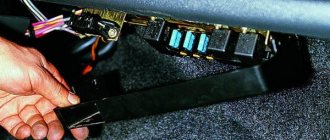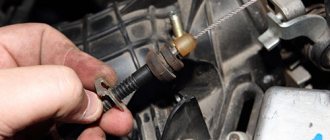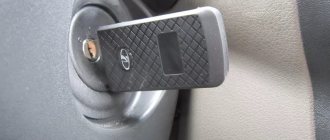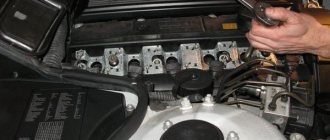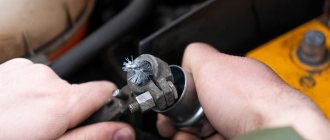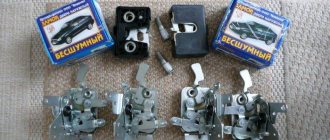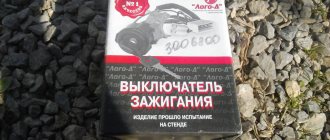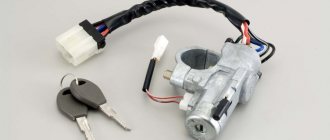Since push-button engine start systems are just beginning to actively appear on the market and it is unlikely that all automakers will abandon conventional ignition using a key, this mechanism will need to be looked after. Most motorists are accustomed to inserting the key into the ignition switch when getting into a car, turning it and thereby starting the engine. Some people repeat this procedure dozens of times a day, others literally 1-2 times. But regardless of the frequency of operation of the vehicle, the key gradually begins to rotate in the lock not entirely correctly. This is due to constant contact between the metals, which leads to the formation of wear, increased friction and possible breakdowns. To prevent metal friction from causing malfunctions in the ignition switch, timely and high-quality lubrication is required. If you approach the issue of operating this unit correctly, no problems or difficulties will arise with turning the key in the lock cylinder. Experienced motorists and experts say that the key to success lies in regular treatment of the larva with lubricants. Moreover, it is important not only to add a small amount of lubricant, but also to select a composition suitable for this mechanism. Not every lubricant can cope with the tasks. Some of them can even be harmful. The basis for processing the lock are substances with a lubricating-penetrating effect.
What and how to lubricate the ignition switch.
How to lubricate a car's ignition switch? Full list and tips
Download PDF
Quite often, drivers are interested in how to lubricate a car’s ignition switch.
After all, it works constantly, and accordingly, its mechanical part wears out quite quickly. Therefore, for normal operation of this unit, it is necessary to lubricate the larva in a timely manner. This will increase the service life of the lock. With proper use of lubricant, you can forget about all possible problems when turning the key. For this purpose, a large number of different substances can be used that have a lubricating and penetrating effect. These can be old antiquated methods, as well as completely modern substances developed for this purpose. How to lubricate a car's ignition switch? In fact, the list of means and substances is quite large. But first, let's figure out under what circumstances you need to lubricate the ignition switch. Be sure to do this twice a year - in spring and autumn. In winter, temperature changes constantly occur in the car. When you eat with the heater on, the air in the cabin warms up to positive values.
When parked, the car cools down quickly. All this causes moisture concentration on various parts of the machine. The ignition switch is no exception. To avoid problems, do not be lazy to lubricate the lock in the fall and spring.
Types of lubricants used
It is necessary to consider which product to take for use. Depending on the problem, a specific type of material must be used. If there are problems with the mechanical part, then specialists use one option. When it is necessary to correct the electrical part, a special composition for processing is required.
Since the assembly includes an electrical unit with contacts, contact lubricant will be in demand for this part.
It is applied in a small layer to the block and exposed parts of the wiring. It is important to know that the composition of the contact lubricant ensures the conductive characteristics of the component being processed. The processing process occurs in stages:
- first you need to lubricate the contact group of the ignition switch;
- then wait a few minutes;
- at the final stage the block can be connected to its seat.
Mechanical lubrication is used to process the larva . This process reduces the risk of the key getting stuck in the hole. It also reduces the likelihood of it getting stuck inside.
Materials with heat-resistant or extreme pressure characteristics are used. Conventional anti-friction compounds can be used. Contact processing should be carried out approximately a couple of times a year. This is often done before the off-season, before the onset of autumn or spring.
Contact lubrication
Do not forget that the ignition switch is primarily an electronic device, or rather a switch. Its work largely depends on nutrition. Therefore, it is important to maintain the contacts of the lock and the block with the power wires in working condition. To do this, the contacts are regularly lubricated with grease. There are a large number of such substances in stores.
When purchasing, pay attention to the conductive properties of the lubricant. Coat the contacts with the selected lubricant, wait a couple of minutes, and connect the block into place. It is recommended to carry out this treatment at least 2 times a year.
.
Replacement
Regardless of the design option and car model, replacement should begin by removing the negative terminal of the battery. On vehicles with an immobilizer and multiple electronic control units, wait at least 3 minutes before removing the terminal. This time will be enough for the blocks to switch to sleep mode, thereby completely eliminating the possibility of losing identifiers, checksums or adaptation codes.
VAZ 2110, 2111, 2112, 114 and 2115 Kalina, Granta, Priora
The main feature of the replacement is that on the specified VAZ models the ignition switch is secured with shear bolts. The head of such bolts breaks off from the stud with a force sufficient to secure the ignition switch housing to the steering column. This design prevents quick access to the contact group and the lock itself, increasing the level of security of the car against theft. In addition to a Phillips and slotted screwdriver, you will need a small chisel and a hammer.
- Remove the plastic steering column cover. Remove the connector plug from the steering column turn switch. For greater freedom of action, the rotation switch can also be removed. Press the chisel blade into the head of the shear bolt so that light tapping with a hammer causes the blade to catch on the head and turn it counterclockwise (the actions are perfectly shown in the video). Often it is enough just to tear off the pin, after which it can be unscrewed by hand. Disconnect the plug of the contact group. In the factory version, the connector wires are connected into single bundles, so be extremely careful when cutting the ties near the wires. Installation of the ignition switch assembly with a contact group is carried out in the reverse order of removal. Instead of shear bolts, the new lock will come with regular bolts and nuts.
Old-fashioned methods
The mechanical part of the switch has its own characteristics and also requires maintenance. Problems most often arise with the lock cylinder. Usually, this manifests itself in a slight jamming of the lock when turning it; in rare cases, it is difficult to insert and remove. If such symptoms appear, you need to lubricate the lock. The easiest way is to do this in a way that not only drivers have long used.
Take motor oil
. It is advisable to choose liquid. Any lubricant can be used, even a spindle will do. Next, take a simple pencil and chop the lead with a sharp knife. The graphite powder obtained in this way is thoroughly mixed with oil. Next, there are 2 options. The easiest way is to lubricate the key with the resulting mixture and insert it into the cylinder. Turn it several times. You can coat it with lubricant again and repeat all the steps. Another method involves using an oil can. With its help, lubricant is injected into the cylinder. In any case, you will forget about problems with the larva for a long time.
Classic methods
Drivers are less likely to get to the contacts, since this requires a small disassembly of the unit. More often, the mechanical part of the lock is processed on the user’s side. It is advisable to carry out the work in advance to prolong the effectiveness of the unit.
You can use spindle oil. However, it is recommended to add fine graphite to it. If it is not available, then use a pencil lead and cut it with a sharp knife or blade.
Mix the resulting powder with an oily liquid and deliver it to the rotation zone. To do this, use one of the methods. In the first case, the composition is applied to the working part of the key, which is then sent into the well. We recommend repeating this at least twice.
For the second method, you will need an oiler with a thin tip. We penetrate the larva with the proboscis and send a sufficient portion of lubricant inside. Both options will allow you to forget about the problem for a long time.
Ready solutions
You can now find a wide variety of lubricants in car dealerships. But, at the same time, many drivers still prefer to use options that have been proven over the years. Most often, aerosol penetrating lubricant “liquid key” or WD-40 is used to lubricate the lock cylinder. These substances have a great effect on the work of the larvae, but there are several nuances. Such lubricants are excellent at retaining moisture. Therefore, using them in late autumn can lead to the accumulation of water in the larva and increased corrosion. This method can be used perfectly in spring and summer.
There are also a large number of different specialized lubricants. They are designed specifically for processing larvae. Buy the substance in aerosol packaging. This will greatly simplify the task of processing the ignition switch. As a rule, it is enough to carry out one such procedure, and the lock starts working like new. You can also use lubricants offered for conventional locks. They will also cope with this task perfectly.
Conclusion
. Normal operation of the ignition switch makes life much easier for the car owner. To avoid any problems with the switch, your task is to properly care for it. This is where the question arises, how to lubricate the car ignition switch. In fact, there shouldn't be any particular problems with this. There are many drugs to tidy up the larvae, as well as contacts. You can also prepare the lubricant yourself.
Specialized materials
Modern manufacturers strive to help drivers solve problems. The abundance of lubricants in car dealerships is proof of this. One of the popular materials for such cases is the popular composition WD40.
Although the foreign product confirms its high efficiency, it is necessary to take into account the nuances in the process. The difficulty lies in the fact that the composition of the “Vedeshki” retains moisture. This fact forces us to abandon its use in the autumn in order to prevent corrosion processes. Spring and summer are suitable for use.
Specialized products are also offered. This lubricant for the car ignition switch will be sold ready-made in a bottle. You can use regular lubricants for classic locks for the cylinder if there is no other option.
How and with what to lubricate a car ignition switch
The topic of how to lubricate the ignition switch is often of interest to motorists. The lock is in constant use, and as a result, its internal parts soon become damaged. Timely lubrication of the cylinder will help extend the “life” of the lock. However, you need to know what you can use to lubricate the part.
If you use the lock correctly, then you don’t have to worry about possible problems with the rotation of the key inside the cylinder. One of the main rules of operation is: regularly lubricate the lock cylinder with suitable compounds. For this purpose, many different substances are provided that have a lubricating-penetrating effect.
When to lubricate the lock
Despite the fact that the list of lock lubricants is quite long, not all formulations are equally good. In addition, thoughtless and too frequent lubrication will not bring anything good.
It is important to understand that regular lubrication of the car ignition switch implies seasonality. In other words, it is recommended to do this with the onset of cold weather and after winter, that is, twice a year. Why? The explanation is simple: in winter and summer, cabin air undergoes temperature fluctuations and changes. Just think about the cost of heating the interior with a stove and then cooling it down in the parking lot in the cold. Temperature changes cause moisture concentration on the ignition switch.
The same thing can happen in the summer. Inside the cabin, the air conditioner turns on, cooling the air. Then the car stops, the heat, the temperature fluctuations are obvious.
So, it turns out that the ignition switch and other interior parts of the car operate under heavy loads due to the concentrate. Therefore, in spring and autumn they need new lubricant.
Of course, there is another reason for lubrication. It is associated with problems with the lock. For example, if the ignition goes out for a short period of time, this is a sign of a stuck key. In this case, after a thorough inspection, lubrication is carried out.
Contact lubrication is carried out at least twice a year, just like regular lubrication.
When processing is required
If you go to any automotive chemical store, you will see a whole scattering of all kinds of lubricants that, in principle, may be suitable for use in the ignition switch. But not all of them are really good and effective. Do not overuse lubricants. It will also not do anything good or useful to your car. The driver will only waste his time and money on constant processing. By choosing the right composition and treating it with the required frequency, the lock cylinder will be the last thing to bother you during the further operation of the vehicle. The frequency of processing directly depends on the season. Therefore, it is correct to apply lubricant before the arrival of winter, as well as after the return of heat. This involves applying the composition twice within one year.
This approach to processing the ignition switch is not difficult to explain. In summer and winter, the temperature inside the cabin is different, it constantly fluctuates, and strong changes in indicators are observed. Imagine that a cold car is parked in the winter, then the driver gets into it and turns on the heater at full power. The salon heats up and becomes very warm. When the work is done, the car is left in the cold again, the interior cools down, and the temperature again changes greatly. It is temperature changes that are the main provocateur of the formation of condensation inside the ignition switch. In summer the situation is somewhat different. The car is under the scorching sun all day, and therefore it gets hot inside the cabin. When a driver gets behind the wheel, the first thing he does is try to cool down. And that's why air conditioners were invented. The car owner arrived at his destination, turned off the air conditioning and left the car in the heat again. Again, temperature differences, condensation and moisture in the ignition switch.
Since the lock is constantly under heavy loads, it requires additional help in the form of lubrication. It will protect against the negative effects of temperature changes and moisture. Treatment should be carried out in the fall, when severe cold has not yet set in, and in the spring, when it gradually gets warmer. The possibility of other reasons that may require lubrication cannot be ruled out. This is mainly due to malfunctions in the operation of the lock itself. Sometimes the key gets stuck and won't turn, making it difficult to start the engine. First, the lock should be carefully inspected, disassembled if necessary, and then contact lubricant should be added. It is also applied twice a year, as is the case with conventional preventive lubricant.
What is contact and mechanical lubrication of a lock?
In addition to the fact that a modern lock is a mechanical device, it is also an electronic terminal, or rather a switch. Its functioning largely depends on electrical power. This, in turn, indicates that it is important to maintain the lock contacts and blocks with wires in working condition, and for this it is necessary to periodically lubricate the contacts with a special compound.
Attention. Contact grease is a special composition with conductive properties. In stores you should ask for this option.
The contacts are lubricated as follows: the contacts are coated with the compound, then after a couple of minutes the block is connected in place.
As mentioned above, the lock also needs mechanical lubrication. It needs no less care, because frequent problems arise with the larva. As a rule, this is manifested by the key jamming when turning. In rare cases, the key can be very difficult to even insert into the cylinder or remove. Obviously, when such problems occur, the lock is lubricated.
Composition of greases
| Basic basis | Thickeners | Additives |
| Mineral oils: paraffinic, naphthenic, aromatic | Soaps (Li, Na, Ca, Ba, Al): standard, hydroxide, complex | For work under high pressure conditions |
| Synthetic oils: olefin polymers, acrylic aromatics, esters, ethers, silicones, fluorinated hydrocarbons, fluorinated polyesters | Organic thickeners (soap free): polyurea, PTFE (Teflon), PE (polyethylene) | To reduce wear |
| Inorganic thickeners: bentonite compounds (aluminum oxides), foamed silica | Friction modifiers (anti-friction additives) | |
| Improving adhesion | ||
| Antioxidant | ||
| Anti-corrosion | ||
| Solid additives: molyb disulfide dena, graphite |
Classification of greases
| Subgroup | Index | Application area | Other |
| Anti-friction | |||
| General purpose for normal temperatures | WITH | Friction units with operating temperatures up to 70ºС | |
| General purpose for elevated temperatures | ABOUT | Friction units with operating temperatures up to 110ºС | |
| Multipurpose | M | Friction units with an operating temperature of –30…+130ºС in conditions of high humidity; in sufficiently powerful mechanisms they remain operational down to –40ºС | Multi-purpose lubricants are sometimes called multipurpose lubricants. They can be used in all main friction units of various mechanisms. These lubricants are water resistant and operate over a wide range of speeds, temperatures and loads. However, they are not suitable for replacing all types of anti-friction lubricants. |
| Heat resistant | AND | Friction units with operating temperature ≥150ºС | Heat-resistant lubricants have a maximum operating temperature of 150 to 250 ºС and higher for 10–100 hours. At such temperatures, a limited number of mechanisms operate, so heat-resistant lubricants are produced in small quantities. They are made from scarce synthetic oils with the addition of special thickeners. |
| Frost-resistant | N | Friction units with operating temperature ≤–40ºС | Low temperature lubricants, intended for use at temperatures down to –50 ºС, and in some mechanisms at lower temperatures, are made from lithium soaps and solid hydrocarbons. |
| Extreme pressure and anti-wear | AND | Rolling bearings with contact stresses more than 250 kPa and sliding bearings with specific loads ≥15 kPa | |
| Chemical resistant | X | Friction units in contact with aggressive media | |
| Conservation | |||
| Conservation | Z | Metal products and mechanisms of all types, with the exception of steel ropes and cases requiring the use of preservative oils or hard coatings | |
| Sealing | |||
| Reinforcement | A | Shut-off valves and stuffing box devices | |
| Threaded | R | Threaded connections |
Mixture: spindle + graphite powder
One of the lubrication options. According to experienced drivers, you can select any engine oil, right down to the spindle. However, it should not be lubricated with pure motor oil, but with a composition obtained by mixing part of the oil and graphite powder.
Note. You can get graphite powder from a simple pencil. Use a sharp knife to chop up a little stylus, then mix it thoroughly with the oil.
The lock should be lubricated with this composition as follows:
- Place the key in the container where the composition is located;
- Then, inserting it into the cylinder, turn it several times to the working position and back.
It is recommended to repeat this procedure 2-3 times so that the composition penetrates well into the larva.
There is another lubrication option, but you will need an oil can:
- The oil can is filled with the composition;
- Lubricant is injected into the lock.
Spindle and graphite powder lubricant
This is a fairly popular lubricant among car enthusiasts, which is in deserved demand due to its high efficiency. Motorists themselves claim that various motor oils can be used for lubrication, including spindle oil. But it is not recommended to use just clean motor oil to treat the ignition switch, regardless of its quality. To obtain a truly effective composition, you need to add graphite powder to the oil. It’s also interesting that you don’t have to go out and buy graphite powder on purpose. It is enough to take a simple pencil, from which the powder is extracted. Using a sharp knife, gradually crumble some of the graphite. Grind the resulting powder further and then add it to the oil. This mixture has a fairly high degree of effectiveness. But to achieve the desired result, follow a few rules. Namely:
- Prepare graphite-oil lubricant using good graphite and clean engine oil;
- Take the ignition key and place it in a container with prepared lubricant;
- Take out the key, insert it into the cylinder and twist it several times;
- The key rotates in the lock to the working position and back several times;
- Remove the key from the ignition, dip it in the lubricant again and repeat the procedure several times.
Repeating the procedure several times will allow you to add a sufficient amount of lubricant to the ignition switch cylinder. If you have a small oil can that is suitable for such small work, the procedure can be completed much faster. The lubricant obtained by mixing oil and graphite is poured into an oil can and the composition is injected into the larva. Then it is still recommended to operate the key in the ignition switch to distribute the lubricant over all internal surfaces.
Ready-made formulations
In stores today you can buy a large number of ready-made lubricants for ignition switches. Interestingly, most experienced drivers use conventional aerosol VD-40. They consider “Vedushka” to be a lubricant that has been tested over the years and easily penetrates the lock cylinder.
And indeed, this is so. Thanks to the special internal chemical composition, VD-40 perfectly lubricates internal mechanisms, penetrates deeply and does not have any harmful deposits.
On the other hand, the use of VD-40 is not recommended in the fall, since the composition tends to retain moisture. This will also contribute to the accumulation of water inside the larva, which will lead to increased corrosion. But in spring or summer, VD-40 can be used without fear.
There is another series of aerosol formulations designed specifically for treating lock cylinders. What's good about aerosol packaging is that it makes it possible to simplify the execution procedure. The oil enters the lock under pressure, which allows the lubricant to completely penetrate the mechanisms. Once treated with a high-quality aerosol composition, the lock begins to function immediately if it has no other malfunctions.
Ready-made lubricants
For most drivers, the easiest way is to buy ready-made lubricant for the car ignition switch. This is not surprising, since there is a wide range of all kinds of products on the market. Moreover, you can easily find a lubricant designed specifically for processing the ignition switch, as the manufacturer writes about on the packaging. Ready-made oil formulations are perfect for performing larvae processing tasks. It is best to buy mixtures presented in aerosol form with special attachments. This packaging allows you to perform the treatment literally in 1 minute, without getting your hands dirty and without having to make the lubricant yourself. Since the substance penetrates inside the ignition switch under the influence of pressure, this allows the composition to quickly and evenly distribute over the internal surfaces of the mechanism. If you use a high-quality aerosol, a single application of lubricant will be more than enough. This will allow the lock to return to its previous functionality. But provided that there are no other more serious problems, to eliminate which you will have to dismantle and disassemble the unit.
Although a large number of ready-made lubricants are produced, I would like to pay special attention to the popular favorite WD40. Many motorists consider this tool the best assistant in working with vehicles. And often, WD40 is used to treat the ignition switch to avoid the key getting jammed in the cylinder and other consequences of wear of metal elements. WD40 has been on the market for many years. This is a proven lubricant that can very easily penetrate into various mechanisms and devices, including ignition lock cylinders. This characterization is quite fair. The composition of the product can really effectively lubricate mechanisms, penetrate deeply and not leave behind harmful deposits.
But in the autumn period before the onset of winter, it is not recommended to use WD40. This is due to the presence of moisture retention properties in the product. This feature will lead to moisture gradually beginning to accumulate inside the larva. This will not give the best effect of increased corrosion formation. But if you add WD40 to the ignition switch in the spring and summer, you will receive excellent protection that will ensure the safety of the mechanism until the fall. Starting in the fall, you should use a different lubricant that will not retain moisture inside the lock.
When choosing a lubricant for processing the ignition switch, focus on its composition, physicochemical properties and temperature conditions under which the vehicle is operated. Finding a suitable substance is now very easy. Just go to an automotive chemical store and ask for a composition specifically designed for ignition switches and deep penetration into the cylinders. Trust trusted and well-established brands. They value their reputation, and therefore it is not in their interests to produce low-quality goods. Although such lubricants will be somewhat more expensive than little-known analogues, the lock requires very little mixture. Therefore, even one bottle will be enough for you to use your car for several seasons.
The ignition switch should always be given attention. And it is better to carry out preventive treatment of mechanisms, preventing their wear, than to then deal with jamming caused by deformation and violation of the geometry of the key or cylinder due to constant friction, blockages and deposits inside the mechanism.
Ignition switch malfunctions: do-it-yourself repair and replacement
The ignition switch is actively used during vehicle operation and quite often fails. Among the main problems are the following breakdowns:
- ignition switch contact group;
- ignition lock cylinder;
Malfunctions of the contact group lead to the fact that after turning the key in the ignition switch, power is not supplied to the vehicle systems. Problems with the lock cylinder prevent the key from being turned or pulled out. In any case, the ignition switch needs to be repaired or replaced. Read more in our article.
Arbor-2
- Answer
#2101 shilodv
Experienced Opel Driver
- City: Severodvinsk
- Car: Opel Meriva A Z16XEP MT 2007
- @Mention
So, the time for cranking the starter to a complete stop at +4 on the street and 14 V on the condensers was 9 seconds, at 12 V - 5 seconds. The spark plugs are screwed in, the chip is removed from the coil block.
- Amber said thank you for this
- Top
- Answer
- Quote
#2102 romko11
- Car: meriva a
- @Mention
Hello everyone, such a problem happened, the ignition switch died for a long time (what ways out of this situation are there?
- Top
- Answer
- Quote
#2103 vladik44
- City: Belarus,Gomel
- Car: Opel Meriva A z1.8xe mt 2003
- @Mention
We go to a store with auto parts or a car market, take a new lock (cylinder), rearrange the secrets and use it. If you need to drive for now, then turn it from the side of the contact group with a screwdriver (read: start it) and drive until you buy a new cylinder. But not for long, they say that this causes the contact group to break up. There was information on the site and there is information on the Internet. Read it.
P.S. In my purchased larva there were 1 fewer seats for secrets than in my own castle. Rearranged one less secret. Let's move on.
Post edited by vladik44: April 10, 2022 — 12:02
- Ambr, URFINGUS and O677ME said thank you
- Top
- Answer
- Quote
#2104 X-ray13
- City: Pskov
- Car: Opel Meriva A Z16XEP MT Cosmo Metro
- @Mention
Good afternoon everyone.
But I had another problem with the ignition switch. I re-read the entire thread about the ignition switch, but did not find any reasons or solutions to this problem.
For some time now (I can’t even understand why this happened) the castle began to behave strangely. If after a trip you turn off the engine and turn the key to position 0, you can only start the car again if you remove the key from the ignition (this turns off the radio) and reinsert it.
Otherwise, the lock performs all its functions properly.
The lock cylinder never jammed, I never removed or disassembled it.
Additional lubrication cannot solve the problem.
I'm at a loss.
It’s better when “you have it, but you don’t need it” than “you have it, but you don’t.” "
- Top
- Answer
- Quote
#2105 Alexander A.
- Car: MERIVA,A,2007,z16xep,MT,cosmo
- @Mention
@X-ray13 Clarify a little what it means the second time and after the key is completely removed from the lock. Is your secret lock stuck or missing contacts after turning the key in the rear lock?
- Top
- Answer
- Quote
#2106 O677ME
- City: Nizhny Tagil
- Car: Opel Meriva 1.6MT2008
- @Mention
Good afternoon everyone. But I had another problem with the ignition switch. I re-read the entire thread about the ignition switch, but did not find any reasons or solutions to this problem. For some time now (I can’t even understand why this happened) the castle began to behave strangely. If after a trip you turn off the engine and turn the key to position 0, you can only start the car again if you remove the key from the ignition (this turns off the radio) and reinsert it. Otherwise, the lock performs all its functions properly. The lock cylinder never jammed, I never removed or disassembled it. Additional lubrication cannot solve the problem. I'm at a loss.
- Top
- Answer
- Quote
Ignition switches: main faults
The main task of the ignition switch is to connect electrical consumers in the car to the power source. However, the design also contains anti-theft elements (steering lock), electronic immobilizers, etc.
- The most common malfunction is failure of the contact group. The ignition switch contacts overheat and burn, especially if a short circuit occurs in the power circuits of electrical equipment.
- The second problem may be the lock cylinder. In this case, the key is inserted, but it cannot be removed. The reason is wear and tear, as the cylinder and key wear out naturally. In this case, the lock may not turn, that is, the engine cannot be started.
- On modern cars, additional anti-theft elements integrated into the lock may fail. This leads to the fact that the key is not “recognized” by the system, and engine starting is blocked.
How to repair an ignition switch
Do-it-yourself ignition switch repair usually involves the following steps:
- replacing the ignition switch;
- replacing the lock cylinder;
- repair of the lock contact group;
- replacement of contact group.
To complete the work, you will need to prepare a set of wrenches, flat and Phillips screwdrivers, and a multimeter. You may also need a plastic spatula to remove small trim panels (depending on the car model), etc.
Replacing the lock
Replacing the ignition switch is not a difficult operation. The main thing is to have a new lock assembled and have easy access to the old lock to remove it.
- Before starting work, you must disconnect the battery terminals;
- Next, the castle cladding is dismantled;
- Then disconnection and dismantling is carried out;
- The final stage is the installation of a new lock and its connection;
Replacing the larva
In a situation where the ignition switch works, but the key turns with great difficulty, gets stuck or does not turn completely, the cause of the problem is the lock cylinder. In this case, you can limit yourself to replacing only the cylinder or servicing it (replacing the ignition switch assembly is impractical).
To restore functionality you need to:
- remove the cylinder and then try to lubricate the mechanism;
- if the problem is not solved, then the larva will need to be replaced.
Repair or replacement of contact group
In a number of cases, it is discovered that when carrying out repairs, the ignition switch turns out to be fully operational and does not need to be changed.
However, the problem is the contact group of the ignition switch. Contacts are responsible for connecting circuits and supplying electricity to vehicle units and systems.
- If the key turns in the lock, but the power consumers do not turn on, the ignition switch on the car will need to be removed. Then you can limit yourself to replacing the contact group, which is purchased separately.
- The contact group can also be cleaned (if it rotates). Cleaning contacts from dirt also allows you to restore functionality without the need to replace individual elements.
Please note that if the contact group is burnt, cleaning will not achieve the desired result. In this case, replacement is the solution.
Diagnostics and repair of the ignition switch
To find out whether the device can be replaced or whether it can be repaired, it must be dismantled, disassembled and inspected.
Before proceeding with removal, it is necessary to exclude other factors affecting engine starting (battery, fuses, etc.). If everything is in order, then you need to:
- disconnect the battery;
- remove the protective cover on the steering column;
- unscrew the fastening bolts;
- disconnect the block with wires;
- release the lock;
- Inserting the key into the ignition switch and turning it slightly, remove the lock from the seat.
After dismantling, you need to carefully inspect the lock, disassemble it and, if necessary, clean the contacts and cylinder. If only cleaning is required, then these works will help restore its functionality. During assembly, it is necessary to lubricate the mechanical parts, and lubricate the contact group parts with a special dielectric grease.
Sometimes it is difficult to visually determine the cause of an ignition switch malfunction. In this case, it is better to contact a special service, whose employees are provided with special tools and have the appropriate qualifications.
In some cars, you need to know certain nuances to dismantle the device. When repairing the ignition switch in St. Petersburg with your own hands, you can ruin the appearance of the trim, which also speaks in favor of contacting a car service center.
Recommendations
Please note that if the ignition switch is faulty, replacement and other work should only be carried out if the “+” terminal on the battery is disconnected!
- Before purchasing a new ignition switch, cylinder or contact group, you must make sure that these elements are faulty. It happens that by all indications the ignition switch is broken, but in reality it only needs an inspection. However, a complete replacement of the ignition switch is not needed so often. There is a high probability that cleaning and lubricating the lock will return the device to full functionality.
- If the key is difficult to turn in the lock or is difficult to insert/pull out, you can try to lubricate the lock superficially (without disassembling). It is enough to apply a little lubricant (such as WD-40) to the top of the cylinder and also treat the key itself. The main thing is not to try to pour a lot of lubricant into the lock.
- To remove the cylinder when disassembling the lock, insert the key into the cylinder and remove the cylinder. To disconnect the cylinder and the cylinder, it may be necessary to remove the cotter pin (the cotter pin is removed with a long thin screwdriver/knitting needle and pliers);
- After any work on the ignition switch, it is necessary to check its functionality before reinstalling it and reassembling it. After connecting the lock, you need to check how easy it is to insert, turn and remove the key. The quality of work of the contact group is also checked.
- Some car enthusiasts, when repairing a lock, throw away some of the “secrets” from the cylinder. Doing this is strictly prohibited! First, the anti-theft properties of the ignition switch are greatly deteriorated. Second, after removing the key from the ignition switch, the lock itself may remain in the ignition on position. This will lead to battery discharge, possible problems with electrical equipment, immobilizer malfunctions, etc.
Lock removal procedure
In order to properly lubricate the mechanical part of the ignition switch, you will need to remove it. To do this, first remove the casing from the steering shaft. Then remove all the screws that secure the lock itself.
Insert the key into the zero position of the lock and disable the anti-theft device. Through the hole in the bracket, press the lock with a screwdriver, then remove the core from the bracket itself and the key from the lock.
Be sure to remember the order in which the wires are connected. Marking the contact group will help you avoid getting confused.
After disconnecting all the wires from the ignition switch, carefully remove the cylinder from the holder along with the key. Pull out the key while holding the slats with your fingers. Take them out one at a time, having previously written down the location.
Wash the lock parts and treat them with a very thin layer of lubricant. Reassemble the mechanism in reverse order. Upon completion of the procedure, check the contacts in all possible positions of the key, as well as the operation of the anti-theft device.
After connecting the contact group and the lock into place, you can begin to operate the vehicle.
How and with what to lubricate car door locks
Almost every car owner sooner or later faces the problem of poor opening or closing of the door lock, as well as creaking door hinges. This happens due to untimely care for them. A huge number of motorists forget about the need to lubricate the door lock or hinges. Timely lubrication will keep the hinges and lock of the car in proper condition and prolong the service of these elements. Quite often, applying lubricant to the main parts of a car is considered one of the activities that is carried out as part of the technical inspection of the vehicle. This will avoid problems in the future due to premature wear or rust on these parts.
What types of lubricants are there? 1. White lithium grease. This substance is considered the thickest with excellent moisture-repellent characteristics. It is better to apply this lubricant to parts of parts where there is contact with negative factors, such as rain, snow, dirt and others. This lubricant has proven itself in working with metal parts, namely, hinges and latches in the rear doors. 2. WD-40. This lubricant is used not only for car parts, but is also suitable for daily use. It is used to remove rust. Thanks to its silicone characteristics, WD-40 can lubricate areas that contain non-metallic parts. This type of substance can be used for nylon, plastic and other materials. 3. Graphite lubricant. Many motorists have noted that this type of material is ideal for lubricating locks, as it helps repel dust and dirt that can harm the locking mechanism.
Using lubricants for car locks and hinges. The use of various types of lubricants is quite simple to perform and does not require special equipment. Graphite lubricant is applied in a small amount to the parts of the car door lock or luggage compartment. WD-40 can be used on the gas tank latch or hinge and on all door hinges. The use of the latter composition makes it possible to achieve high functionality of parts that at first glance seem to be metal, but in fact some of their components are made of non-metallic material. WD-40 will do a great job of fixing problems with the hood latch.
White lithium grease is used to eliminate various defects and extend the service life of hood or trunk hinges. This lubricant is sprayed onto the surfaces of the parts after they are cleaned with a cotton or microfiber cloth.
For more thorough coverage, lubricant is applied to both sides of the part. Excessively applied substance is removed from the surface using a soft cloth, which avoids scratching car parts.
Before you start lubricating hinges or door locks, it is worth performing a preparatory procedure. It consists of cleaning the hinge and lock with a small amount of solvent or multi-purpose lubricant. Apply the solvent in sufficient quantity to the articulated joint or moving part of the part.
Bottom line. Before the start of the winter season, many car enthusiasts recommend servicing the car, performing so-called preparation for winter. Particular attention should be paid to door locks. They should be cleaned of dust and dirt and lubricated. This will make them run more smoothly and be less susceptible to freezing in sub-zero temperatures.
How to lubricate car door locks
160 2 179k
How to lubricate door locks ? This question plagues many car enthusiasts with the arrival of frost. The set of measures to prepare the car for winter also includes lubrication of door locks, trunk, hood, as well as lubrication of seals. For this purpose, special means are used, the purpose of which is to ensure reliable operation of locks even in severe frost conditions. In this material we will review the most popular lubricants among car enthusiasts, and also give useful tips on this matter.
Properties of lubricants
First of all, let's figure out what requirements the means for lubricating door locks must meet. These include:
- maintaining its performance properties at low temperatures;
- counteraction to corrosion processes;
- low friction coefficient;
- resistance to washing off not only with water, but also with various compounds based on salts and alkalis;
- long period of validity.
The product must be hydrophobic, that is, one that is not soluble in water. Otherwise, it will be easily washed out of the cavity. It should also prevent moisture from entering the volume where it is placed.
Lubricants for car door locks
Now let's look at the most popular means for processing locks, their cylinders and mechanisms. On the Internet you can find many conflicting reviews about this or that product. We tried to be objective and collected information for you about lubricants that are really effective even in severe frost conditions . It is also worth mentioning that most of the products listed below can be successfully used to treat not only locks and their cylinders, but also door hinges.
Also, when treating the lock, pour the products listed below not only into the cylinder, but also treat the mechanisms directly with them. This can be done with or without removing the lock. It all depends on the design of the particular car. For example, it is better to remove the locks of domestic VAZs completely and lubricate the rubbing parts. And in foreign cars, where dismantling is complicated by the design, you can lubricate only the accessible parts of the lock.
Molykote Liquid Grease G 4500
Molykote Liquid Grease G 4500
This is one of the most popular means for lubricating car door lock cylinders. Its operating temperature range is -40°С…+150°С. The lubricant is absolutely harmless to humans and does not emit harmful substances into the atmosphere. In addition, it is compatible with metals, plastics, rubber and various chemical compounds found in the machine body. The manufacturer claims a 3-month warranty for use even in difficult operating conditions. The most popular package size is 400 ml (although there are packages of 5 kg or more). The approximate cost of such a tube in Moscow in the fall of 2022 is 1300.1400 rubles.
- base oil - polyalphaolefin;
- thickener—a thickener based on an aluminum complex;
- operating temperature range - -40°С…+150°С;
- critical load (Timken method) - more than 177 N;
- starting moment at a temperature of -40°C - 0.9 Nm.
This tube will last you for several seasons depending on the intensity of use.
Step Up SP5545
The temperature range of this lubricant is even wider - -50°C...+220°C. Sold in aerosol cans weighing 312 g. The product is suitable not only for lubricating car door locks, but also for its other parts. After all, since the lubricant is based on casting, it can be used to treat plastic and rubber surfaces to protect them from moisture and destruction.
The lubricant contains the original WetOut composition, which creates a water-repellent film on the treated surface. It will help extend the life of not only the iron parts of the lock, but also the rubber seals and plastic trim parts. The price of a tube weighing 312 grams is 160.180 rubles in Moscow as of fall 2022.
HI-GEAR HG5501
The lubricant is also silicone-based. When applied to a work surface, it forms a thin but durable polymer material that reliably protects it from moisture. In fact, the lubricant is universal, so in addition to cars, it can be used in other equipment - with household door locks, rubber and plastic surfaces, drive cables and much more. It is also possible to use the product in everyday life with products made from the listed materials.
The container capacity is 283 ml. The kit includes a plastic tube that can be connected to the sprayer and apply lubricant to hard-to-reach places. The price of the cylinder is about 400.450 rubles as of autumn 2022.
Wurth HHS-2000
Wurth HHS-2000 grease
Wurth HHS-2000 08931061 lubricant is extremely popular among car enthusiasts in our country. According to the instructions, it is intended for lubricating parts under high pressure and loads. Like the previous product for lubricating car door locks, it is universal. Its features include:
- High penetrating ability and short thickening time. It can be used to lubricate car door locks. Using a tube, it is placed inside the lock, where it almost immediately becomes thick, forming a protective film on the surface of the parts and simultaneously displacing moisture. The composition of the product provides a high lubricating effect.
- High adhesion. That is, the ability to adhere to the surface being treated. During processing, the liquid fraction evaporates, leaving only direct lubricants in the work.
- High pressure resistance. Wurth HHS-2000 grease has a long service life even under conditions of high loads and pressures.
- The product prevents sticking of metal surfaces and also reduces screwing resistance.
Wurth HHS-2000 lubricant is sold in small cylinders of 150 and 500 ml. Since the product is universal, we recommend that you buy it for use not only in the car, but also at home. The price of a 150 ml cylinder is approximately 250.300 rubles as of autumn 2022.
LIQUI MOLY Pro-Line Haftschmier Spray
LIQUI MOLY Pro-Line Haftschmier Spray
LIQUI MOLY Pro-Line Haftschmier Spray 7388 lubricant is universal. It can also be used to lubricate car door locks. It is an adhesive spray lubricant, packaged in 400 ml cylinders. The product can be used to treat hinges, levers, joints, bolts, door hinges, preservation and operation. Features of the lubricant include:
- wide temperature range of use;
- excellent adhesive properties;
- providing anti-corrosion protection;
- resistance to both cold and hot water (it is practically not washed off);
- resistance to high pressure;
- long service life;
- Possibility of spraying in any position of the cylinder.
The only drawback of this product is its high cost - 600.700 rubles for a 400 ml cylinder. However, if you have the opportunity, we recommend that you buy this product, since it can be used in various parts of the car, as well as at home.
Despite the entire track record of products suitable specifically for lubricating car door locks, car owners are often in no hurry to overpay. As a rule, they are looking for something that can be used to lubricate door locks from freezing or from difficult opening that are directly at hand, so we will provide a list of folk remedies used for lubrication.
Additional means to lubricate the lock
The lubricants described above relate to modern developments and results of the chemical industry. However, before their appearance, drivers for decades used various improvised means to lubricate locks and door hinges. For example, kerosene, acetic acid and even iodine. Let’s present for you a couple more, so to speak, “folk” remedies that you can use to lubricate car door locks for the winter. After all, it is during the cold season that locks create additional difficulties in order to get inside or close the door. And the question of which lubricant is better to lubricate becomes more relevant.
Processing of VAZ 2108-2109 locks
Yes, the good old WD-40 lubricant can also be used to inject into the lock cylinder, but in no case on all its rubbing mechanisms. The fact is that the main component of this product is white spirit (50% of the volume), whose freezing point is -60°C. Therefore, it washes away any remaining lubricant. The liquid is sold as an aerosol in a can with a tube, with which you can easily spray the product into hard-to-reach places.
WD-40 lubricant can be used to dehydrate the surface to which it is applied, removing corrosion from it and preventing its reappearance, forming a protective film on it. In general, the product is used very widely. And not only for processing car parts, but also in everyday life.
When treating a door lock with a “wedeshka” (both automobile and household), it is advisable to apply silicone grease to the same surfaces. You can use one of the lubricants listed above, or use any other.
Lock defroster
In this case, we are talking about special products, the packaging of which says “Lock defroster” or something similar. They usually contain oil or white spirit, less often silicone. Such products are inexpensive and work well, at least in relatively mild frosts. The disadvantage of these products is their short duration of action, since their composition is similar to WD-40.
When purchasing such lubricants, carefully read the instructions. Manufacturers often attribute truly miraculous properties to their products. However, you need to understand that if the product is inexpensive (and most often it is), then you shouldn’t expect any miracles from it. Just regularly treat the lock cylinder and mechanism with “Lock Defrosters” in the winter and you won’t have any difficulties opening it. But only in the spring, after using it, it is recommended to treat the lock mechanism with a different composition. In particular, one that could protect against corrosion and friction.
Engine oil
If for some reason you don’t have any lubricant on hand (one of the above or others), then you can use regular motor oil to lubricate the car door lock both from freezing and for stable operation. Its viscosity, brand and consistency are not important in this case (well, unless it should be frankly black with soot and debris). Using a syringe or other similar devices, you should pour a few drops of oil into the cylinder and/or treat the lock mechanism. This will create a water-repellent film on the surface of its internal parts and prevent freezing.
However, the oil has the disadvantage mentioned above - its effect is short-lived and will also attract dust. Therefore, it can only be used if you do not have more professional means at your disposal. And at the first opportunity, buy any of the lubricants listed above.
